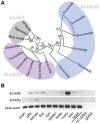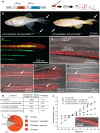Bioelectric signaling regulates size in zebrafish fins
- PMID: 24453984
- PMCID: PMC3894163
- DOI: 10.1371/journal.pgen.1004080
Bioelectric signaling regulates size in zebrafish fins
Abstract
The scaling relationship between the size of an appendage or organ and that of the body as a whole is tightly regulated during animal development. If a structure grows at a different rate than the rest of the body, this process is termed allometric growth. The zebrafish another longfin (alf) mutant shows allometric growth resulting in proportionally enlarged fins and barbels. We took advantage of this mutant to study the regulation of size in vertebrates. Here, we show that alf mutants carry gain-of-function mutations in kcnk5b, a gene encoding a two-pore domain potassium (K(+)) channel. Electrophysiological analysis in Xenopus oocytes reveals that these mutations cause an increase in K(+) conductance of the channel and lead to hyperpolarization of the cell. Further, somatic transgenesis experiments indicate that kcnk5b acts locally within the mesenchyme of fins and barbels to specify appendage size. Finally, we show that the channel requires the ability to conduct K(+) ions to increase the size of these structures. Our results provide evidence for a role of bioelectric signaling through K(+) channels in the regulation of allometric scaling and coordination of growth in the zebrafish.
Conflict of interest statement
The authors have declared that no competing interests exist.
Figures






Similar articles
-
A calcineurin-mediated scaling mechanism that controls a K+-leak channel to regulate morphogen and growth factor transcription.Elife. 2021 Apr 8;10:e60691. doi: 10.7554/eLife.60691. Elife. 2021. PMID: 33830014 Free PMC article.
-
Bioelectric-calcineurin signaling module regulates allometric growth and size of the zebrafish fin.Sci Rep. 2018 Jul 10;8(1):10391. doi: 10.1038/s41598-018-28450-6. Sci Rep. 2018. PMID: 29991812 Free PMC article.
-
Integrated K+ channel and K+Cl- cotransporter functions are required for the coordination of size and proportion during development.Dev Biol. 2019 Dec 15;456(2):164-178. doi: 10.1016/j.ydbio.2019.08.016. Epub 2019 Aug 28. Dev Biol. 2019. PMID: 31472116 Free PMC article.
-
Developmental change in the function of movement systems: transition of the pectoral fins between respiratory and locomotor roles in zebrafish.Integr Comp Biol. 2014 Jul;54(2):238-49. doi: 10.1093/icb/icu014. Epub 2014 Apr 17. Integr Comp Biol. 2014. PMID: 24748600 Free PMC article. Review.
-
Zebrafish fin and heart: what's special about regeneration?Curr Opin Genet Dev. 2016 Oct;40:48-56. doi: 10.1016/j.gde.2016.05.011. Epub 2016 Jun 25. Curr Opin Genet Dev. 2016. PMID: 27351724 Review.
Cited by
-
Physiological inputs regulate species-specific anatomy during embryogenesis and regeneration.Commun Integr Biol. 2016 Jul 15;9(4):e1192733. doi: 10.1080/19420889.2016.1192733. eCollection 2016 Jul-Aug. Commun Integr Biol. 2016. PMID: 27574538 Free PMC article.
-
Precise control of ion channel and gap junction expression is required for patterning of the regenerating axolotl limb.Int J Dev Biol. 2020;64(10-11-12):485-494. doi: 10.1387/ijdb.200114jw. Int J Dev Biol. 2020. PMID: 33200809 Free PMC article.
-
Evolution of two-pore domain potassium channels and their gene expression in zebrafish embryos.Dev Dyn. 2024 Aug;253(8):722-749. doi: 10.1002/dvdy.690. Epub 2024 Jan 25. Dev Dyn. 2024. PMID: 38270285 Free PMC article.
-
The role of TASK-2 channels in CO2 sensing in zebrafish (Danio rerio).Am J Physiol Regul Integr Comp Physiol. 2020 Sep 1;319(3):R329-R342. doi: 10.1152/ajpregu.00132.2020. Epub 2020 Jul 22. Am J Physiol Regul Integr Comp Physiol. 2020. PMID: 32697653 Free PMC article.
-
Information integration during bioelectric regulation of morphogenesis of the embryonic frog brain.iScience. 2023 Nov 4;26(12):108398. doi: 10.1016/j.isci.2023.108398. eCollection 2023 Dec 15. iScience. 2023. PMID: 38034358 Free PMC article.
References
-
- Huxley JS, Teissier G (1936) Terminology of relative growth. Nature 137: 780–781.
-
- Gould SJ (1966) Allometry and size in ontogeny and phylogeny. Biol Rev Camb Philos Soc 41: 587–640. - PubMed
-
- Metcalf D (1963) The autonomous behaviour of normal thymus grafts. Aust J Exp Biol Med Sci 41: SUPPL437–447. - PubMed
-
- Metcalf D (1964) Restricted growth capacity of multiple spleen grafts. Transplantation 2: 387–392. - PubMed
Publication types
MeSH terms
Substances
Grants and funding
LinkOut - more resources
Full Text Sources
Other Literature Sources
Molecular Biology Databases

